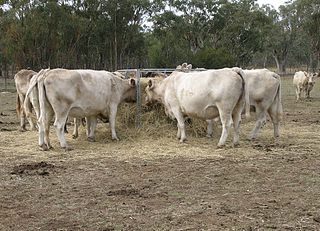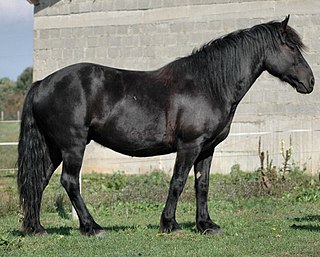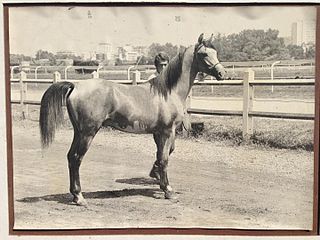Related Research Articles

Horse breeding is reproduction in horses, and particularly the human-directed process of selective breeding of animals, particularly purebred horses of a given breed. Planned matings can be used to produce specifically desired characteristics in domesticated horses. Furthermore, modern breeding management and technologies can increase the rate of conception, a healthy pregnancy, and successful foaling.

The Byerley Turk, also spelled Byerly Turk, was the earliest of three stallions that were the founders of the modern Thoroughbred horse racing bloodstock.

The Camargue, French: Camarguais or Cheval de Camargue, is a traditional French breed of working horse indigenous to the Camargue area in southern France. Its origins are unknown. For centuries, possibly thousands of years, these small horses have lived wild in the harsh environment of the Camargue marshes and wetlands of the Rhône delta, which covers part of the départements of Gard and Bouches-du-Rhône. There they developed the stamina, hardiness and agility for which they are known today. Traditionally, they live in semi-feral conditions in the marshy land of the region. The Camargue horse is the traditional mount of the gardians, the Camargue riders who herd the black Camargue bulls used for courses camarguaises in southern France.
Gem Twist was a 16.3 hands world champion American Thoroughbred show jumping horse registered under the name Icey Twist. Bred by equestrian Frank Chapot, Gem Twist had an incredible career at the Grand Prix level. The gelding is the only horse to have won the "American Grand Prix Association Horse of the Year" title three times, and is regarded as one of the best show-jumpers in history.

A stud animal is a registered animal retained for breeding. The terms for the male of a given animal species usually imply that the animal is intact—that is, not castrated—and therefore capable of siring offspring. A specialized vocabulary exists for de-sexed animals and those animals used in grading up to a purebred status.

A mare is an adult female horse or other equine. In most cases, a mare is a female horse over the age of three, and a filly is a female horse three and younger. In Thoroughbred horse racing, a mare is defined as a female horse more than four years old. The word can also be used for other female equine animals, particularly mules and zebras, but a female donkey is usually called a "jenny". A broodmare is a mare used for breeding.

Álvaro Affonso de Miranda Neto, more commonly known as Álvaro de Miranda or "Doda" Miranda, is an Olympic-class Brazilian show jumping rider. He was married to Athina Onassis. He is president of the organizing committee behind the Athina Onassis International Horse Show, which debuted in 2007 as the fifth stage of the Global Champions Tour in São Paulo. In 2008, the AOIHS-São Paulo event was the final phase of the tour. For the tour in 2009, the host city of the AOIHS was Rio de Janeiro.

The Mérens, Cheval de Mérens or Caballo de Merens, still occasionally referred to by the older name of Ariégeois pony, is a small, rustic horse native to the Pyrenees and Ariégeois mountains of southern France, where the river Ariège flows, and northern Spain, near Andorra. Two general types, a small, light traditional mountain horse and a taller, sportier modern type, are found. Always black in color, Mérens must meet strict physical standards in order to be registered in the stud book. The breed is known for its sure-footedness on mountain terrain, as well as for its endurance, hardiness and docility. The French breed registry organizes regional offices, and partners with other national organizations in Europe to preserve and promote the breed. The organization enforces rigorous selection of breeding stock, with a goal of increasing quality in the breed. In the past, the Mérens was used for farm work, draft work and as pack horses. Today it is mainly used as a saddle horse, although some members of the breed have been successful in carriage driving. Many Mérens are taken on an annual transhumance, in which they are moved higher in the mountains during the summer and into the valleys for the winter. An old practice, it fell into disfavor, but has recently re-emerged.

The Poitevin or Poitou is a French breed of draft horse. It is named for its area of origin, the former province of Poitou in west-central France, now a part of the region of Nouvelle-Aquitaine. It was formed in the seventeenth century when horses of Flemish or Dutch origin, brought to the area by engineers working to drain the Marais Poitevin, interbred with local horses. Although it has the size and conformation of a draft horse, the Poitevin has never been bred for draft abilities, and has been little used for draft work. Its principal traditional use was the production of mules. Poitevin mares were put to jacks of the large Baudet du Poitou breed of donkey; the resulting Poitevin mules were in demand for agricultural and other work in many parts of the world, including Russia and the United States. In the early twentieth century there were some 50,000 brood mares producing between 18,000 and 20,000 mules per year.

Makfi is a British-bred, French-trained Thoroughbred racehorse and sire. In 2010 he won the 2000 Guineas and Prix Jacques Le Marois.

The Norman Cob or Cob Normand is a breed of light draught horse that originated in the region of Normandy in northern France. It is of medium size, with a range of heights and weights, due to selective breeding for a wide range of uses. Its conformation is similar to a robust Thoroughbred, and it more closely resembles a Thoroughbred cross than other French draught breeds. The breed is known for its lively, long-striding trot. Common colours include chestnut, bay and seal brown. There are three general subsets within the breed: horses used under saddle, those used in harness, and those destined for meat production. It is popular for recreational and competitive driving, representing France internationally in the latter, and is also used for several riding disciplines.

The Henson Horse, or Cheval de Henson, is a modern horse breed from northeast France. It was created by the selective breeding of light saddle horses with the smaller, heavier Norwegian Fjord horse to create small horses suitable for the equestrian vacation industry. The breeders' association, Association du Cheval Henson, was formed in 1983. In 1995 the studbook was closed to horses not born from Henson parents, and in 2003 the breed was officially recognised by the French government agencies for horse breeding. A hardy breed of horse, each winter the broodmares and youngstock from several breeders are let loose together to graze freely in the wetland reserves in France.

Make Believe is a British-bred, French-trained Thoroughbred racehorse. After winning both his races as a two-year-old he developed into a top-class performer in 2015, recording Group One victories in the Poule d'Essai des Poulains and the Prix de la Forêt.
Horse cloning is the process of obtaining a horse with genes identical to that of another horse, using an artificial fertilization technique. Interest in this technique began in the 1980s. The Haflinger foal Prometea, the first living cloned horse, was obtained in 2003 in an Italian laboratory. Over the years, the technique has improved. It is mainly used on high-performance but castrated or infertile animals, for reproductive cloning. These horses are then used as breeding stock. Horse cloning is only mastered by a handful of laboratories worldwide, notably in France, Argentina, North America and China. The technique is limited by the fact that some differences remain between the original and its clone, due to the influence of mitochondrial DNA.
A neigh is the sound made by horses, horse hybrids such as the hinny, and other equines, such as the zebra. It consists of a succession of jerky sounds, initially high-pitched and gradually lower. Produced on exhalation by the larynx and modulated, it enables the animal to express its emotions and to inform other animals through the sound produced. The main function of neighing is to alert other equines to its presence in the absence of visual communication. However, horses rarely neigh.

Catapulte is a pinto-bay show jumping mare of Dutch origin, registered in the Belgian Sport Horse studbook (SBS). French rider Michel Robert acquired Catapulte in 2007, following her first foaling, to train her in show jumping. In 2012 and 2013, Catapulte won numerous prizes, but she never reached Grand Prix level. Despite this, she gained fame and a dedicated fan club.

Persik, born on 1 April 1969 and died on 24 August 2001, was a gray-coated Arabian horse who was the leading sire in the equestrian discipline of endurance from 1975 until his death in 2001. His eclectic origins include Polish and Russian bloodlines, as well as French and English, in particular the famous Skowronek. Purchased in 1973 from the Tersk stud farm, Persik was imported to France by Jean Cougul, a breeder from Vigoulet-Auzil, then bought by the Cévennes National Park with the aim of breeding horses suitable for trail riding. In 1975, Persik won the first edition of a well-known endurance race, the 130 km de Florac.

The Arabo-friesian is a recent breed of horse, selected over several generations since the 1960s to obtain the morphology of the modern Friesian combined with the endurance qualities of the Arabian. The creation of this breed was strongly contested by some Dutch Friesian breeders, who went so far as to set fire to the stables where the first crosses were made.

Mylord Carthago is a gray Selle Français stallion and show jumping champion. Sired by the Selle Français stallion Almé Z and the Holsteiner stallion Carthago, his potential was recognized very early on. At the age of seven, he was entrusted to Norman rider Pénélope Leprévost, who trained him and made him her lead horse. The pair went on to win European and World show jumping runner-up titles in 2010 and 2012. Combining sport with his breeding career, Mylord is also one of France's last national stallions. The threat of his sale after the 2014 World Equestrian Games has led to a number of negative reactions, both from the show jumping public and from political figures.

Quickly de Kreisker is a Selle Français show jumping stallion born on February 5, 2004 at a stud in Finistère. Sired by Diamant de Semilly and Briseis d'Helby by Laudanum, he was sold by the Fences agency as a two-year-old. He spent several years in France on the classic cycle, trained by Benjamin Robert and Bruno Souloumiac's Breton stables. At the end of 2012, King Mohammed VI of Morocco bought him under Marcel Rozier's supervision, and entrusted him to Abdelkebir Ouaddar, a Moroccan rider.
References
- ↑ "Première sortie d'un clone de champion". Le Figaro. 2006. Retrieved 16 December 2019.
- 1 2 "Les Stars des Jeux". Cheval Magazine. 2013. p. 30.
- ↑ Coghlan, Andy (2005). "First clone of champion racehorse revealed". New Scientist. Retrieved 12 October 2017.
- 1 2 "Champion endurance horse cloned". BBC News. 2005. Retrieved 10 September 2019.
- ↑ "Le clonage des chevaux et les marchands du temple génétique". Revue Médicale Suisse.
- 1 2 "Le poulain Pieraz, clone de champion". 20minutes.fr. 2006. Retrieved 12 October 2017.
- ↑ "Informations générales de PIERAZ Z CL". infochevaux.ifce.fr. Retrieved 10 September 2019.
- ↑ "Chevauché le poulain Pieraz-Cryozootech-Stallion". Industries et Technologies. 2005. Retrieved 10 September 2019.
- ↑ Jeangirard, Emmanuel (2005). "Pieraz Cryozootech Stallion, un poulain plein de vie". L’Éperon. Retrieved 12 October 2017.
- ↑ "Heure Exquise ! PIERAZ - GEOFFROY Christiane". www.exquise.org. Retrieved 10 September 2019.
- 1 2 Conti, Julie (2008). "Hippisme. Des clones de champions au service de l'élevage". Le Temps.
- ↑ "Le clonage équin en représentation à Rambouollet".
- ↑ "Première sortie d'un clone de champion". Le Figaro.
- ↑ Génopole (2005). "Naissance du clone d'un cheval d'exception castré". Futura Santé. Retrieved 12 October 2017.
- ↑ Palmer, Eric. "Premières images de sperme d'un étalon cloné!". www.cryozootech.com.